Dan Thompson's Blog, page 12
February 6, 2013
Painting Practice
 Not much to say on writing today, other than the fact that I’ve just missed the first milestone for my stretch goals for this year. I’m not giving up on it just yet, though, since that schedule had some slack built in.
Not much to say on writing today, other than the fact that I’ve just missed the first milestone for my stretch goals for this year. I’m not giving up on it just yet, though, since that schedule had some slack built in.
 However, I have been doing some artwork.
However, I have been doing some artwork.
 In preparation for doing more covers this year, I figured it was time to practice my art skills again. I’ve done a lot of work in 3D rendering before, but even at my best, I was still hitting that uncanny valley in about half of my work. After talking it over with an artist friend, he suggested I work with Corel Painter instead.
In preparation for doing more covers this year, I figured it was time to practice my art skills again. I’ve done a lot of work in 3D rendering before, but even at my best, I was still hitting that uncanny valley in about half of my work. After talking it over with an artist friend, he suggested I work with Corel Painter instead.
 Painter lets you work from a reference photograph, doing your brushwork on a transparent layer over the original image. The idea being that you can start with some source material and give it a more painted appearance, and theoretically, a painted look will back me out of the uncanny valley.
Painter lets you work from a reference photograph, doing your brushwork on a transparent layer over the original image. The idea being that you can start with some source material and give it a more painted appearance, and theoretically, a painted look will back me out of the uncanny valley.
 So, I’ve been practicing, and I’m posting eight of my results here. Four are from photographs, and four are from my renders. Of course, I can easily tell which are which since I know which ones are mine, but I also know a bit of what I’m looking for.
So, I’ve been practicing, and I’m posting eight of my results here. Four are from photographs, and four are from my renders. Of course, I can easily tell which are which since I know which ones are mine, but I also know a bit of what I’m looking for.
 Still, I’m hoping they’ll be less obvious than before. The idea, I suppose, is that I’ll eventually do my covers either based on my own renders, stock photography, or some mix of the two and then repaint the cover to give a more unified appearance.
Still, I’m hoping they’ll be less obvious than before. The idea, I suppose, is that I’ll eventually do my covers either based on my own renders, stock photography, or some mix of the two and then repaint the cover to give a more unified appearance.
 Either that, or I’ll simply throw in the towel and start hiring it out.
Either that, or I’ll simply throw in the towel and start hiring it out.
February 4, 2013
Downton Abbey via Science Fiction
 I’ve recently started watching Downton Abbey — I’m only on season 1, so please no spoilers — and I was trying to explain it to my wife. She wanted to know what it was about and why it appealed to me so much. Certainly, it’s a fine show, and I could have talked about it in specifics, but instead, I fell back on our common language of science fiction.
I’ve recently started watching Downton Abbey — I’m only on season 1, so please no spoilers — and I was trying to explain it to my wife. She wanted to know what it was about and why it appealed to me so much. Certainly, it’s a fine show, and I could have talked about it in specifics, but instead, I fell back on our common language of science fiction.
You see, it reminds me a lot of C.J. Cherryh’s Foreigner series with Bren Cameron and his Atevi household. In Downton Abbey, a sudden change has brought about a new heir to the title and the estate, but he’s not an aristocrat. Instead, he’s a middle-class lawyer, mostly interested in contracts and such, much like how Bren is more of a linguist than a politician.
Watching this new heir adapt to a life with servants and formal dinners was a lot like watching Bren adapt to his Atevi household, full of servants, bodyguards, and more potential social gaffes than priceless relics.
 Then there’s the Dowager Countess, who fits the mold of the Dowager-Aiji Ilisidi almost perfectly, right down to the cane. She’s proud, opinionated, and not accustomed to losing.
Then there’s the Dowager Countess, who fits the mold of the Dowager-Aiji Ilisidi almost perfectly, right down to the cane. She’s proud, opinionated, and not accustomed to losing.
As for the household staff, they don’t match well with the Atevi characters, apart from the fact that they all have surprising back stories and secrets. However, I was able to describe the worst of them, Thomas, as a like Mr. Morden from Babylon 5, except without a conscience. At least Morden believed he was serving a higher purpose, whereas Thomas is simply selfish and evil.
Now, if anything, the development of ideas was the reverse of this. The stratified society of British aristocracy came long before Cherryh’s Atevi, and it may have very well served as inspiration for her setting. However, both she and I have grown up more on science fiction than on history, so I find myself relating new tales back to “the classics” of Star Trek, Star Wars, the Foundation trilogy, and so on.
Am I the only one? Have you ever run across some mainstream story that mostly reminded you of your sci-fi/fantasy roots?
February 1, 2013
Review: Erinyes, by Scott McElhaney
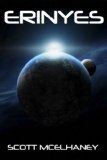
 I was really disappointed by this book, all the more so because the premise was so intriguing. A man wakes up from cryogenic freeze to discover that not only has his cancer been cured but that he’s untold thousands of years in the future and on a ship exploring another galaxy. The mystery of why they wanted him and a few other “popsicles” for this mission was enough to pull me forward through the story.
I was really disappointed by this book, all the more so because the premise was so intriguing. A man wakes up from cryogenic freeze to discover that not only has his cancer been cured but that he’s untold thousands of years in the future and on a ship exploring another galaxy. The mystery of why they wanted him and a few other “popsicles” for this mission was enough to pull me forward through the story.
Alas, I found most of the other characters frustrating as their moods flipped around unpredictably, and the rest of the backstory around their mission and what’s happened on Earth was not very compelling. Then the story seemed to run out of steam and jump to the climax without much of any build-up, and when the mystery of why they wanted these 21st century popsicles for the mission, I was sadly disappointed. I won’t spoil it here, but I found myself saying, “Really? That’s the best they could do? Who the heck planned this mission?”
With better characters, better plotting, and a better explanation for why these guys were there, this could have been an awesome book. But it wasn’t. I hate to write bad reviews, but this one just didn’t work for me.
Review: Erinyes, by ScottMcElhaney

 I was really disappointed by this book, all the more so because the premise was so intriguing. A man wakes up from cryogenic freeze to discover that not only has his cancer been cured but that he’s untold thousands of years in the future and on a ship exploring another galaxy. The mystery of why they wanted him and a few other “popsicles” for this mission was enough to pull me forward through the story.
I was really disappointed by this book, all the more so because the premise was so intriguing. A man wakes up from cryogenic freeze to discover that not only has his cancer been cured but that he’s untold thousands of years in the future and on a ship exploring another galaxy. The mystery of why they wanted him and a few other “popsicles” for this mission was enough to pull me forward through the story.
Alas, I found most of the other characters frustrating as their moods flipped around unpredictably, and the rest of the backstory around their mission and what’s happened on Earth was not very compelling. Then the story seemed to run out of steam and jump to the climax without much of any build-up, and when the mystery of why they wanted these 21st century popsicles for the mission, I was sadly disappointed. I won’t spoil it here, but I found myself saying, “Really? That’s the best they could do? Who the heck planned this mission?”
With better characters, better plotting, and a better explanation for why these guys were there, this could have been an awesome book. But it wasn’t. I hate to write bad reviews, but this one just didn’t work for me.
January 30, 2013
It’s Not the Idea
A few years back, I heard some authors complaining about what was apparently a fairly common problem: the fan with an idea. It’s a fabulous, original idea for a novel, you see, and the fan is more than willing to let the author write it for a mere fifty percent of the profits. The authors all laughed knowingly.
Now that I’m on the far side of a few novels, I can see why they laughed. The idea is important, yes, but it’s at most five percent of the work. Far more important is the execution of that idea, namely, the long drawn-out process of actually writing the book, structuring the tale, fine-tuning the language, and finding that snappy opening that draws in the reader. Plus, we’re mostly just retelling the same basic struggles that have been around since the Greeks.
One guy told us about how he had actually followed the fan up to his hotel room, since he was at least a friend of a friend, so that the fan could share this amazing idea in private, far away from any nefarious eavesdroppers. And the super amazing idea? Well, you see… this guy goes back in time and kills his father before he was even conceived. Again, a knowing laugh went around the circle.
From there, the authors segued off to talk about the fastest novel they’d ever written, including their internal edits. Times ranged from three to eleven months, but one author told us about a guy he knew who was popping out a new book every 3-4 weeks, month after month, year after year. He did it all under multiple pen names and in different genres. None of the novels were exactly Shakespeare, but they were all reasonable and sold moderately well.
Somewhat jealous, the other authors shook their heads at this prodigious productivity, making their singular fever-fast novels pale by comparison. “Damn,” one of them complained, “what do you even say to a guy like that?”
From the audience, I quipped, “Well, you see, I’ve got this idea, and for only half the profits…”
January 28, 2013
Little Galileo

 I bought my daughter a telescope for Christmas. It’s a 70mm refraction telescope with a 9x and 25x eyepieces. I confess I’d been hankering for something bigger, maybe in the 4-6 inch reflecting range, but they were much pricier, and all the reviews pointed to this as an excellent starter telescope. I also knew it was powerful enough to see Saturn’s rings.
I bought my daughter a telescope for Christmas. It’s a 70mm refraction telescope with a 9x and 25x eyepieces. I confess I’d been hankering for something bigger, maybe in the 4-6 inch reflecting range, but they were much pricier, and all the reviews pointed to this as an excellent starter telescope. I also knew it was powerful enough to see Saturn’s rings.
So, we put it together, confirmed that the red-dot viewfinder was properly aligned, and waited for a clear night. And waited. And waited. That last week of December was pretty cloudy here in central Texas, but it did clear eventually, so we grabbed the telescope and headed out into the frigid night — well, at least as cold as it gets in this part of Texas, i.e. about 25F.
I had not done any preparation or research. I had no plan of observation. I had no star charts. Even the little star-map app on my phone was a bust since my phone is pretty poor at detecting its own orientation. But I figured we could just go out, point the telescope at some light in the night sky, and see what it was, a bit like those astronomers of the early 1600′s. Even with me living somewhat out in the country, they probably had much less light pollution than I did, but the quality of my optics were vastly better than theirs.
First of all, with 70mm of light-gathering aperture, the moon is way too bright to look at. Seriously. It wasn’t quite “do not look at moon with remaining eye, but I could see the moonlight blasting out of the eyepiece, illuminating dust particles. So, I gave up on any direct moon observations until we could add some kind of dark moonlight-filter to the setup.
Then I pointed it at some bright light about 20 degrees above the horizon. I used the viewfinder to line it up, then peered through the eyepiece only to find it empty. I looked through the viewfinder again to see that I was off target. I figured I must have bumped it, so I lined it up again, went to look, and damn, still nothing there. By the time I went to line it up again, I could actually see the thing moving. It was an airplane.
By this point, my nine-year-old daughter’s excitement is turning to impatience. It was literally — yes, literally — freezing out there, and all she had gotten for her troubles so far was to watch me play with her Christmas present.
I looked up at the sky, trying to find something interesting. I saw the constellation of Orion, and remembered something vague about how one of the stars in Orion’s belt was actually a nebula, or maybe a galaxy. Or was that in the sword hanging down from the belt? My daughter started pacing to stay warm.
A little bit up north from Orion, however, was a particularly bright light. I knew my compass directions well enough to know it wasn’t Polaris, so I figured there was a decent chance it was a planet. Given how far it was from the now-set sun, I knew it couldn’t be Mercury or Venus, and its color did not make me think of the red Martial soil at all. I didn’t think Uranus or Neptune could be seen with the naked eye, so I figured it was Jupiter or Saturn. Either one should make for an interesting peek.
So I pointed the telescope up, got down on the concrete of the driveway and peered through the viewfinder. I got the red-dot lined up on the bright light and took a look through the eyepiece.
For the first time, I was rewarded with not a blank field or some blinding moon. It wasn’t even a point anymore. It was a circle. It wasn’t a giant disk with swirling clouds and a big red dot, but it was clearly a circle. There were no rings, either, but this was clearly a planet, not some distant star.
I fine-tuned the position controls to center it, and handed it over to my daughter. “I think that’s Jupiter,” I told her.
 She looked through it and waved her arms in excitement. I told her to be careful not to bump the telescope, and she calmed down and peered some more. Eventually she stood, looked back up at the point in the sky and asked, “What are those dots next to it?”
She looked through it and waved her arms in excitement. I told her to be careful not to bump the telescope, and she calmed down and peered some more. Eventually she stood, looked back up at the point in the sky and asked, “What are those dots next to it?”
I looked up and only saw a scattering of other stars. “What dots?”
“In the telescope,” she said. “There are dots next to Jupiter.”
So I sat down on the ground and looked in the eyepiece again. Sure enough, there were four dots around Jupiter, two on each side, evenly spaced. I realized I had noticed them before but dismissed them as some optical artifact between the telescope lenses and my contact lenses. The spacing and arrangement was just too regular to be anything else. Or maybe I’ve just seen too many lens flare effects in recent Sci-Fi movies.
But no matter how much I blinked, the dots did not go away. Eventually they started drifting up out of the view as the Earth rotated, so I used the fine-tuning controls to bring them back into view. They were still there. I angled my head one way and another, but no matter what I did, they remained persistently visible and kept themselves aligned the same way.
That’s when it hit me. These were not optical artifacts. These were the four big moons of Jupiter: Io, Europa, Ganymede, and Callisto.
“They’re moons,” I told her. “Those are four of Jupiter’s moons.”
“Jupiter has moons?” she asked incredulously.
“Yes,” I told her all proud of passing on this knowledge, but then I realized that she was the one who had spotted them, not me. I had dismissed them as tricks of the light, but she had noticed them and wanted to know what they were. “They’re the four biggest moons of Jupiter, and you just discovered them.”
She looked back through the telescope again solemnly. “Moons… cool.”
 Since then, we’ve talked about how Galileo first saw them through his telescope just over 400 years ago. We’ve gone looking since, and seen them with different spacing, including seeing only three, figuring that one was either in front of or behind Jupiter. I’m trying to explain to her how you can discern that these different observations allowed Galileo to discern that they were circling Jupiter. The theological and political implications of that in what was then still officially an Earth-centered universe will have to wait until she’s a little older.
Since then, we’ve talked about how Galileo first saw them through his telescope just over 400 years ago. We’ve gone looking since, and seen them with different spacing, including seeing only three, figuring that one was either in front of or behind Jupiter. I’m trying to explain to her how you can discern that these different observations allowed Galileo to discern that they were circling Jupiter. The theological and political implications of that in what was then still officially an Earth-centered universe will have to wait until she’s a little older.
It’s easy for us to think of those early astronomers like Galileo as epic figures, locked in a struggle against the stratified philosophies of the universe. Yet, at the heart of it, he was just a curious fellow who asked the same question my little girl just asked. “Just what are those dots next to Jupiter?”
January 25, 2013
Review: Ship’s Boy, by Phil Geusz
 This was an odd little space opera about an anthropomorphized rabbit named David Birkenhead. That’s right, he’s a rabbit walking around in clothes an interacting with humans. (If any of you remember the comic strip Hepcats from the 80′s, it’s a bit like that.) Now, it’s not as odd as that makes it sound. He’s a member of a genetically engineered slave race, designed to be dumb, compliant labor for the ruling humans.
This was an odd little space opera about an anthropomorphized rabbit named David Birkenhead. That’s right, he’s a rabbit walking around in clothes an interacting with humans. (If any of you remember the comic strip Hepcats from the 80′s, it’s a bit like that.) Now, it’s not as odd as that makes it sound. He’s a member of a genetically engineered slave race, designed to be dumb, compliant labor for the ruling humans.
And he gets dragged onto a nobleman’s starship as it is fleeing an invasion, and along the way he manages to prove himself capable, and as the crisis escalates further, he even gets to step up to the plate and be a hero.
I suppose my only complaint was that it was a little short…
… so I went ahead and grabbed the next one in the series.
Review: Midshipman, by Phil Geusz
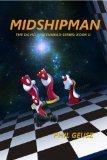
 In this book, David Birkenhead is still technically a rabbit, but he’s now a free rabbit, no longer considered a slave by law. But as he recovers from his injuries and considers his future, it’s clear that most people still consider him to be a slave in all but paper.
In this book, David Birkenhead is still technically a rabbit, but he’s now a free rabbit, no longer considered a slave by law. But as he recovers from his injuries and considers his future, it’s clear that most people still consider him to be a slave in all but paper.
As much as the anthropomorphized animal aspects might be weird — my wife, for example, was a little squicked by it – it actually served as an interesting proxy for our own history of racial slavery in the U.S. In many cases I could see people treating the rabbits in much the way old slaveholders of the U.S. south would have treated them, and I also see what that slavery has done to the rabbits psyche, in terms of their expectations, their choices, and their self-image. More than any furry aspect, it was this comfortable view of slavery that got under my skin more than anything else.
So, this book takes David from his injuries through to his official decoration for his heroic actions in the first book, and then onto the navy’s officer academy with the Kings full blessing. Of course, not everyone wants to see David succeed as the first free rabbit to enter the academy, and there’s quite a bit of good struggle over that. Along the way, he befriends a few other students in the academy, and for the climax, they go to an interstellar wargames competition between two opposing academies. He acquits himself fairly well in a move that would have made even Ender Wiggin proud.
So, I’m pretty jazzed about it, even with the bunny ears and slavery, and I’m looking forward to the rest of the series.
January 23, 2013
The Value of Doing It Wrong
We’ve all heard it. “Do it right the first time.” We’ve also probably heard, “Dude, you’re doing it wrong.” Then there are further admonishments to learn from other people’s mistakes, to listen to the experts, and that we should pay attention to our elders because any fool with half a brain knows better than to do it the way you are. Well, give them their due. They probably know what they’re talking about.
But… there is still a lot of value to doing it the wrong way first.
Now, before you all go skydiving with bedsheets or rewire your homes with twine, I’m mainly talking about learning a new skill, whether it’s hitting a baseball, playing an instrument, or writing a novel. So, don’t run off in pursuit of a Darwin Award. This is for skills where failure doesn’t kill you.
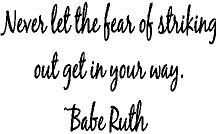 The first valuable thing that comes from doing it wrong the first time is that you’ve actually done it the first time. I can’t tell you how many people I hear talking about the things they want to do someday, as soon as they can take the time to learn how. They’re not actually going to try it out, sign up for lessons, or even pick up the necessary tools, but “someday”, they’re going to learn it.
The first valuable thing that comes from doing it wrong the first time is that you’ve actually done it the first time. I can’t tell you how many people I hear talking about the things they want to do someday, as soon as they can take the time to learn how. They’re not actually going to try it out, sign up for lessons, or even pick up the necessary tools, but “someday”, they’re going to learn it.
How? By osmosis?
No. The best way — perhaps the only way — to learn a skill is to do it over and over. That means doing it that very first time, and almost certainly doing it wrong. You’re holding the bat too high. You’re squeezing the reed too hard. And for God’s sake, drop the prologue! Yeah, whatever… at least you’ve done it.
The next valuable result of doing it wrong is that you start to learn what failure looks like. Sure, we see the experts perform, and we sure know what success looks like, but stupefying failure? Not so much. So yeah, sending your bat flying towards the shortstop — not so good. You tried to play a scale, and now the dogs are whimpering. And maybe the sixty-four pages on the preparation of tea leaves distracts a bit from your political thriller.
Knowing what failure looks like is the key to moving towards success, an after multiple encounters with it, you develop a feeling for failure. You know its different shades. You can judge its severity. You can even anticipate it, knowing that the technique you’re about to employ is perhaps not such a good idea.
You’ll also learn the kinds of failure that you are particularly prone to. Do you shift your weight before the pitcher throws? Do you always botch the fingering combinations that require your pinky? Do you drop exposition into dialog with “As you know, Bob….” Sure, others have made these mistakes. Others have made millions of mistakes, and while you want to avoid them, trying to keep all of them in your head will paralyze you into inaction. Don’t stick your butt out too far. Keep your shoulder low. Don’t start the swing too early. Don’t start it too late. Watch your pinky finger. And avoid adverbs when bunting the clarinet!
No, you learn the errors you are prone to, and those are the ones you watch out for. All those other errors you don’t make? Just forget about them. Those mistakes were never part of your style to begin with.
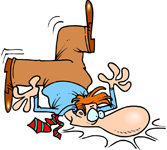 Style? Where did that come from? It turns out that’s the other valuable thing that comes from doing it wrong. Some folks say you should study the styles of the masters: Babe Ruth, Benny Goodman, William Faulkner. While there’s nothing wrong with checking them out, the simple fact is that you’re not them. And more to point, they are not you. Their style might not work for your body, your brain, or your kind of story.
Style? Where did that come from? It turns out that’s the other valuable thing that comes from doing it wrong. Some folks say you should study the styles of the masters: Babe Ruth, Benny Goodman, William Faulkner. While there’s nothing wrong with checking them out, the simple fact is that you’re not them. And more to point, they are not you. Their style might not work for your body, your brain, or your kind of story.
Instead, your unique path of errors and mistakes will set your style, because we all approach success from different directions. While some might see this as saying we all walk up with our own limps and stumbles, by the time we really know what we’re doing, those limps and stumbles have become stylish skips and dramatic rolls. These quirks might look odd and add nothing to our ultimate success, but they are part of what works for us, and they make us stand apart from all the Faulkner wannabe’s out there.
And finally, in rare cases, that thing we’re doing wrong turns out to be better than the” right way”. I point you to Dick Fosby, the failure who revolutionized the high jump. In high school, he could not clear the five-foot bar using the standard straddle method. He then attempted the upright scissors method, which made it look like he was having a seizure in mid-air. It was an improvement, but he still wasn’t doing well.
But then he started doing something wrong. He went over the high-jump bar backwards and landed on his back. This was completely inappropriate, and the only reason it was allowed at all was because the rules required the flexibility between the straddle and scissor methods. And yet, this quirky approach worked for Fosby. In fact, it worked so well, that he began winning competitions, and in 1968, he set a new Olympic record using what had become known as the “Fosby Flop.” Today, it is the standard high jump technique across the globe.
So, on the point of writing, feel free to do it wrong. Most of it will fail, but you’ll get better. Along the way, you’ll find your style, and you just might find something even better, a new way of doing things. Chances are you won’t find anything, but don’t avoid something quirky just because someone told you were doing it wrong. Storytelling is a big world. Who knows what’s out there?
Hell, you might even resurrect the prologue.
January 21, 2013
Sci-Fi as Progressive Propaganda
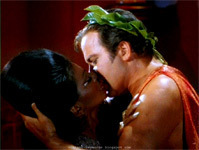 Science fiction has a long history of presenting us with new and progressive ideas, from free love in Stranger in a Strange Land to some commanding women characters in the recent Battlestar Galacitca, but probably the most famous progressive moment in SF was when midway through Star Trek’s third season, Lieutenant Uhura kissed Captain Kirk in America’s first televised mixed-race kiss.
Science fiction has a long history of presenting us with new and progressive ideas, from free love in Stranger in a Strange Land to some commanding women characters in the recent Battlestar Galacitca, but probably the most famous progressive moment in SF was when midway through Star Trek’s third season, Lieutenant Uhura kissed Captain Kirk in America’s first televised mixed-race kiss.
But it almost wasn’t didn’t happen.
At the end of the first season, actress Nichelle Nichols was about to return to her roots of singing on stage. Her appearance in Star Trek had significantly raised her visibility, and she was ready to start on Broadway, her greatest aspiration as a singer. This was her big break.
So one Friday afternoon after production had wrapped for the season, she went to Gene Roddenberry’s office, explained the situation, and handed him her resignation. He told her she couldn’t possibly leave, that he desperately needed her to stay on the show. “Don’t you understand what I’m trying to do here?”
She was not swayed, but she agreed to think about it over the weekend.
The very next night, she was on stage for an NAACP fundraiser. Afterwards, one of the organizers asked her if she would be willing to meet a fan. She agree, expecting the typical Trekkie of the era, but much to her surprise, it was Martin Luther King. “I’m the fan,” he said. “I’m your best fan. I am your biggest fan.”
Ms. Nichols was flabbergasted, amazed that such an important figure as Dr. King even knew who she was, let alone watched the show, but he was clearly not faking it. He went on about what an important role model she was, since she was one of the first black women to appear on screen as anything other than a servant or entertainer. Eventually, she managed to find her voice, thanked him, and mentioned that she was going to miss it since she was going back to her singing career in the next year.
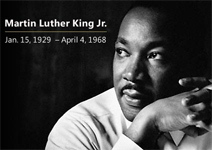 Shocked, Dr. King would not allow this. “STOP! You cannot! You cannot leave this show! Do you not understand what you are doing?! You are the first non-stereotypical role in television! Of intelligence, and of a woman and a woman of color! That you are playing a role that is not about your color! That this role could be played by anyone? This is not a black role. This is not a female role! A blue eyed blond or a pointed ear green person could take this role!
Shocked, Dr. King would not allow this. “STOP! You cannot! You cannot leave this show! Do you not understand what you are doing?! You are the first non-stereotypical role in television! Of intelligence, and of a woman and a woman of color! That you are playing a role that is not about your color! That this role could be played by anyone? This is not a black role. This is not a female role! A blue eyed blond or a pointed ear green person could take this role!
“Nichelle, for the first time, not only our little children and people can look on and see themselves, but people who don’t look like us, people who don’t look like us, from all over the world, for the first time, the first time on television, they can see us, as we should be!
“As intelligent, brilliant, people! People in roles other than slick tap dancers, and maids, which are all wonderful in their own ways, but for the first time we have a woman, a WOMAN, who represents us and not in menial jobs, and you PROVE it, this man [Gene Rodenberry] proves and establishes a precedent that validates what we are marching for because three hundred years from today there we are, and there you are, in all our glory and all your glory! And you CANNOT leave!”
Clearly, Dr. King was more persuasive than Gene Roddenberry had been, and she decided to stay. On Monday, she went back to Gene’s office as asked if the part was still available. Of course, it was. He had already torn up her letter of resignation.
Relieved, she told him what Dr. King had said to her. He listened quietly, and finally replied, “Thank God someone understands what I am trying to achieve.”
And apparently it made a difference. Numerous African-Americans at NASA point to Lt. Uhura as their reason for getting involved in space exploration. Even Whoopi Goldberg credits the Uhura character for her wanting to be on Star Trek:TNG.
We’re still a long way from the ideals of Dr. King’s dream or Roddenberry’s federation, but since today we celebrate Dr. King’s birthday, I thought I would point out that every little bit helps.
January 18, 2013
Review: My Life as a White Trash Zombie, by Diana Rowland


The title on this one really grabbed me, and I just dove in. It’s a first person account of a young Louisiana woman who wakes up in the hospital after a night of heavy drinking only to discover that she’s now a zombie. Well, she doesn’t realize it right away, but as her new job at the county morgue brings into contact with delicious brains, she starts to figure it out.
She’s not the shambling, mindless kind of zombie. Nope, as long as she gets some brains on a regular basis, she can pass for one of the living. And so she begins her new life, working at the morgue and building up a stash of, er… brain food, but she is also dealing with her old white trash life with a drunk father, and drugged-out shit of a boyfriend, and three more years left on probation for a car she didn’t actually steal in the first place.
But how did she become a zombie in the first place? And what’s going on with all these strange murders in town? And OMG! What happened to my stash of brains?!!
So, it was a fun ride, and I really liked our protagonist. It was also a pretty good mystery, trying to figure out how she became a zombie and how the murders tied into it all. About the only thing I had trouble with was the rather effective descriptions of the taste and texture of human brains. Suffice it to say, I won’t be eating any tapioca soon.
There’s a sequel out, and I may give it a look as well.




